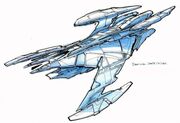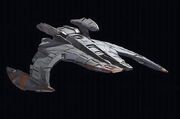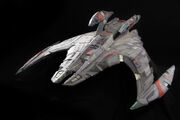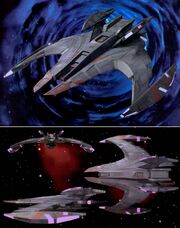m (→Physical studio models: typo) |
m (-dup lk) Tag: sourceedit |
||
| (15 intermediate revisions by one other user not shown) | |||
| Line 1: | Line 1: | ||
{{realworld}} |
{{realworld}} |
||
| − | [[File:Jem'Hadar battle cruiser.jpg|thumb| |
+ | [[File:Jem'Hadar battle cruiser.jpg|thumb|Jem'Hadar battle cruiser]] |
| − | As it became clear that the [[Dominion]] would play an integral part as a continuous threat in the ''[[Star Trek: Deep Space Nine]]'' series, the role of their foot soldiers, the [[Jem'Hadar]], had to be upgraded to emulate the ''[[Star Trek: The Next Generation]]''{{'}}s uncompromising, implacable and daunting [[Borg]]. While the previously introduced [[Jem'Hadar fighter]] filled to some extent that role, a larger capital ship was called for, which the Jem'Hadar eventually received in the guise of the '''[[Jem'Hadar battle cruiser]]''' |
+ | As it became clear that the [[Dominion]] would play an integral part as a continuous threat in the ''[[Star Trek: Deep Space Nine]]'' (DS9) series, the role of their foot soldiers, the [[Jem'Hadar]], had to be upgraded to emulate the ''[[Star Trek: The Next Generation]]''{{'}}s uncompromising, implacable and daunting [[Borg]]. While the previously introduced [[Jem'Hadar fighter]] filled to some extent that role, a larger capital ship was called for, which the Jem'Hadar eventually received in the guise of the '''[[Jem'Hadar battle cruiser]]'''. |
==Design== |
==Design== |
||
| − | [[File:Jem'Hadar battle cruiser design.jpg|thumb|Eaves' design for the Jem'Hadar battlecruiser.]] |
+ | [[File:Jem'Hadar battle cruiser design.jpg|thumb|left|Eaves' design for the Jem'Hadar battlecruiser.]] |
| − | For the episodes {{e|In Purgatory's Shadow}} and {{e|By Inferno's Light}} the script called for a new large Jem'Hadar ship. [[John Eaves]] was given the task of designing the ship in {{y|1996}}. Eaves got his inspiration from the {{w|Douglas A-4 Skyhawk}} aircraft when designing the battle cruiser, "''For the Jem Hedar/Dominion battle cruiser, the A-4 played a major role in the overall look of the ship. This was one of the first war ships that I got to work on during the 4 years on at DS9, For DS my primary job was props and work would spill over into some fun vessel projects every once in a while.''" |
+ | For the episodes {{e|In Purgatory's Shadow}} and {{e|By Inferno's Light}} of ''DS9'', the script called for a new large Jem'Hadar ship. [[John Eaves]] was given the task of designing the ship in {{y|1996}}. Eaves got his inspiration from the {{w|Douglas A-4 Skyhawk}} aircraft when designing the battle cruiser, "''For the Jem Hedar/Dominion battle cruiser, the A-4 played a major role in the overall look of the ship. This was one of the first war ships that I got to work on during the 4 years on at DS9, For DS my primary job was props and work would spill over into some fun vessel projects every once in a while.''" {{Eavesdropping|2009/05/26/the-a-4-and-the-sona-battle-ship/}} Eaves produced a 3/4 view that was quickly approved, "''(...)usually it's the 3/4 so I can see most of what is going on in one drawing!!! it's the fastest way to get a big overview of what your trying to create.(...)this one image was about it!!! I did a rough blue of what you see here, it made a quick approval and went right to ink(...).''" {{Eavesdropping|2009/05/26/the-a-4-and-the-sona-battle-ship/#comment-3225}} |
| + | |||
| + | Despite Eaves' early approval of his design, he had to produce in November 1996 more elaborate plan views for the effects houses to follow. {{Eavesdropping|2009/06/18/new-stuff-from-the-jem-hedar-battle-ship/}} |
||
==Physical studio models== |
==Physical studio models== |
||
[[File:Jem'Hadar battle cruiser studio model.jpg|thumb|The physical studio model]] |
[[File:Jem'Hadar battle cruiser studio model.jpg|thumb|The physical studio model]] |
||
| ⚫ | |||
| − | A physical model was deemed necessary for close-up shots. By this time, [[Brazil-Fabrication & Design]] was no longer available to the franchise, and an outside |
+ | A physical [[studio model]] was deemed necessary for close-up shots. By this time, [[Brazil-Fabrication & Design]] was no longer available to the franchise, and an outside contractor was approached. The model, measuring 48×48 inches, was eventually built by [[Don Pennington]] {{DrexFiles|2009/03/12/klingon-negh-var-transmission-point-sternbach/#comment-2970}}, or as ''DS9'' Visual Effects Supervisor [[David Stipes]] for the episode has put it, "''John Eaves generated top, bottom, front and side drawings, that VisionArt used to create the CGI ship. Animator [[Tony Sansalone]] did the work. Concurrently a model maker named Don Pennington was building a dimensional version. So we wound up building two ships, a physical version and a computer version...''" (''[[Cinefantastique]]'', Vol.29, No.6/7, p. 39) Due to budget constraints, the internally lit model was built from traditional material, cast resin with plastic elements, as the newer light weight composites were outside of the budget, resulting in a heavy and cumbersome model. "''The model was very large and with traditional materials it became very heavy. It took three to four people to safely lift and turn the model over for various shots. It was affectionately dubbed the "Lead Hadar". (The nick-name was earned; I know first hand as I got to help turn it over once.)''", Stipes jokingly remembered.[http://davidstipes.com/blog/?p=293] It has proven to be the next to last specifically built physical starship studio model for a televised ''[[Star Trek]]'' production (the models built later for {{e|A Time to Stand}}, being "[[studio model#Kit-bash|kitbashes]]"), and it was used in subsequent episodes of ''Deep Space Nine'', debuting in "In Purgatory's Shadow" and for the last time appearing in {{e|Sacrifice of Angels}} as stock footage. |
| − | The Jem'Hadar battle cruiser model (measuring 48×48 inches) was listed in the ''[[40 Years of Star Trek: The Collection]]'' |
+ | The Jem'Hadar battle cruiser model (measuring 48×48 inches) was listed in the ''[[40 Years of Star Trek: The Collection]]'' auction as {{stala|1778-0484|Lot 484}}, with an estimated sale price of US$2,000-$3,000; it sold on 6 October 2006 for US$6,000 ($7,200 with premium). A foam core [[studio model|camera test model]] sold as {{stala|8459|Lot 8459}} in August 2008 for US$204.73 in a ''[[It's A Wrap! sale and auction]]''. |
| ⚫ | A second physical Jem'Hadar battle cruiser model, reportedly also a studio model, in a slightly different paint scheme, but not internally lit, showed up as Lot 1487 in the [[Profiles in History]]'s ''Hollywood Auction 40'' of 12 June 2010, estimated at US$6,000-$8,000.{{brokenlink|http://www.profilesinhistory.com/items/hollywood-memorabilia-auction-40/jemhadar-warship-model-fromstar-trek-deep-space-nine.html}}, but was pulled at the last minute from the auction without further clarification, as doubts arose about the claim that the model was actually screen-used and owned by the studio. [http://startrekauction.blogspot.com/2010/06/profiles-pulls-jem-hadar-ship.html] The retraction was a result of aficionado's [[Alec Peters]] scrutiny, who has proven this item to be a display piece for Pennington's own effects shop. [http://startrekauction.blogspot.com/2010/05/profiles-jemhadar-ship-not-from.html] |
||
| ⚫ | |||
| ⚫ | Nevertheless, this model eventually did wound up in the collection of an American collector outside the auction circuit [http://www.therpf.com/f45/jem-hadar-battlecruiser-star-trek-deep-space-nine-90639/], who discovered upon receival of the model, that some parts of it were were in fact the master templates from which the parts were taken to construct the actual studio model. [http://www.therpf.com/f45/jem-hadar-battlecruiser-star-trek-deep-space-90639/#post1317420] |
||
| ⚫ | A |
||
| ⚫ | Nevertheless, this model eventually did |
||
==CGI model== |
==CGI model== |
||
[[File:Jem'Hadar battle cruiser, In Purgatory's Shadow.jpg|thumb|VisionArt's original design version alongside a [[Jem'Hadar fighter]]]] |
[[File:Jem'Hadar battle cruiser, In Purgatory's Shadow.jpg|thumb|VisionArt's original design version alongside a [[Jem'Hadar fighter]]]] |
||
| − | As touched upon by Stipes, |
+ | As touched upon by Stipes, who felt that the intricate scene of the Jem'Hadar fleet approaching through, and interacting with, the [[Bajoran wormhole|wormhole]] could only be executed as a [[CGI]] effect, a CGI model of the battle cruiser was concurrently built at [[VisionArt Design & Animation]] by Tony Sansalone. It made the design one of only two, that was executed simultaneously as a physical as well as a digital variation (the other one being the [[Intrepid class model|''Intrepid''-class studio model]]). VisionArt's model was constructed in SideFx Software's "Prisms", and "Ice" software packages. {{brokenlink|http://geocities.com/Hollywood/1930/ds9.html}} |
| − | Some slight visual differences existed between the CGI model that appeared in "By Inferno's Light", and the CGI cruiser that later appeared in "Sacrifice of Angels". Despite these differences, namely the angle of the nacelles in relation to the hull, the two designs were, in actuality, intended to be the same ship. Confirmation of this was explained by DS9 Visual Effects Supervisor David Stipes at [http://groups.google.nl/group/alt.tv.star-trek.ds9/browse_thread/thread/35cdca475dc0ca75 alt.tv.star-trek.ds9]. There, Stipes would further clarify that "''there are differences that come from changes in the CGI model to make it match the physical model. Remember, the CGI work for these shows were done by different companies at different times.''" |
||
| − | [[File:Jem'Hadar battlecruiser revised CGI model.jpg|thumb|Foundation's upgraded CGI model]] |
+ | [[File:Jem'Hadar battlecruiser revised CGI model.jpg|thumb|left|Foundation's upgraded CGI model]] |
| − | For the episode "Sacrifice of Angels", in which the physical model was also featured for a last time, VisionArt's CGI model was reprogrammed and remapped in the {{w|LightWave 3D}} software at [[Foundation Imaging]] by [[Michael Stetson]] under supervision of [[Ron Thornton]]. (''[[Sci-Fi & Fantasy Models]]'', issue 32, 1998, p. 53) |
+ | For the episode "Sacrifice of Angels", in which the physical model was also featured for a last time, VisionArt's CGI model was reprogrammed and remapped in the {{w|LightWave 3D}} software at [[Foundation Imaging]] by [[Michael Stetson]] under supervision of [[Ron Thornton]]. This action was undertaken to increase production efficiency by using one software format only, LightWave in this case. (''[[Sci-Fi & Fantasy Models]]'', issue 32, 1998, p. 53) |
| + | The digital model as constructed by VisionArts had a slightly different design as its nacelle struts were attached to the hull at a somewhat steeper angle. |
||
| − | The differences between the two designs, in [[Trekkie|fan]] circles referred to as the "V-type" and "U-type", may well have stemmed from misinterpretation of Eaves' original design sketches. By this time production of full orthographic blueprints has become uncustomary for the television productions. As Eves explained in regard to an earlier design of his,"''Most of the time with models all you need is a three-quarter view, and a couple of three-quarter angles on different parts of the ship.''" ({{STTM|1|2}}, p. 22). While reprogramming VisionArt's CGI model, Stetson, who had the physical studio model at his disposal as reference, made use of the opportunity to correct the the angle of the nacelle struts, to have it correspond with that of the physical model. |
+ | Some slight visual differences existed between the CGI model that appeared in "By Inferno's Light", and the CGI cruiser that later appeared in "Sacrifice of Angels". Despite these differences, namely the angle of the nacelles in relation to the hull, the two designs were, in actuality, always intended to be the same ship. Confirmation of this was provided by ''DS9''{{'}}s David Stipes in a [https://groups.google.com/forum/#!msg/alt.tv.star-trek.ds9/Nc3KR13AynU/HhYYDerkfeUJ Google blog], where he would clarify that, ''"Both sets of images ARE the Dominion Cruiser. However, there are differences that come from changes in the CGI model to make it match the physical model. Remember, the CGI work for these shows were done by different companies at different times.''" The differences between the two designs, in [[Trekkie|fan]] circles referred to as the "V-type" and "U-type", may well have stemmed from misinterpretation of Eaves' original design sketches. By this time production of full orthographic blueprints has become uncustomary for the television productions. As Eves explained in regard to an earlier design of his,"''Most of the time with models all you need is a three-quarter view, and a couple of three-quarter angles on different parts of the ship.''" ({{STTM|1|2}}, p. 22). While reprogramming VisionArt's CGI model, Stetson, who had the physical studio model at his disposal as reference, made use of the opportunity to correct the the angle of the nacelle struts, to have it correspond with that of the physical model, as was stated by Stipes. |
[[Category:Studio models]] |
[[Category:Studio models]] |
||
Revision as of 18:08, 23 October 2015
Template:Realworld

Jem'Hadar battle cruiser
As it became clear that the Dominion would play an integral part as a continuous threat in the Star Trek: Deep Space Nine (DS9) series, the role of their foot soldiers, the Jem'Hadar, had to be upgraded to emulate the Star Trek: The Next Generation's uncompromising, implacable and daunting Borg. While the previously introduced Jem'Hadar fighter filled to some extent that role, a larger capital ship was called for, which the Jem'Hadar eventually received in the guise of the Jem'Hadar battle cruiser.
Design

Eaves' design for the Jem'Hadar battlecruiser.
For the episodes "In Purgatory's Shadow" and "By Inferno's Light" of DS9, the script called for a new large Jem'Hadar ship. John Eaves was given the task of designing the ship in 1996. Eaves got his inspiration from the Douglas A-4 Skyhawk aircraft when designing the battle cruiser, "For the Jem Hedar/Dominion battle cruiser, the A-4 played a major role in the overall look of the ship. This was one of the first war ships that I got to work on during the 4 years on at DS9, For DS my primary job was props and work would spill over into some fun vessel projects every once in a while." [1] Eaves produced a 3/4 view that was quickly approved, "(...)usually it's the 3/4 so I can see most of what is going on in one drawing!!! it's the fastest way to get a big overview of what your trying to create.(...)this one image was about it!!! I did a rough blue of what you see here, it made a quick approval and went right to ink(...)." [2]
Despite Eaves' early approval of his design, he had to produce in November 1996 more elaborate plan views for the effects houses to follow. [3]
Physical studio models

The physical studio model

The second physical studio model
A physical studio model was deemed necessary for close-up shots. By this time, Brazil-Fabrication & Design was no longer available to the franchise, and an outside contractor was approached. The model, measuring 48×48 inches, was eventually built by Don Pennington [4](X), or as DS9 Visual Effects Supervisor David Stipes for the episode has put it, "John Eaves generated top, bottom, front and side drawings, that VisionArt used to create the CGI ship. Animator Tony Sansalone did the work. Concurrently a model maker named Don Pennington was building a dimensional version. So we wound up building two ships, a physical version and a computer version..." (Cinefantastique, Vol.29, No.6/7, p. 39) Due to budget constraints, the internally lit model was built from traditional material, cast resin with plastic elements, as the newer light weight composites were outside of the budget, resulting in a heavy and cumbersome model. "The model was very large and with traditional materials it became very heavy. It took three to four people to safely lift and turn the model over for various shots. It was affectionately dubbed the "Lead Hadar". (The nick-name was earned; I know first hand as I got to help turn it over once.)", Stipes jokingly remembered.[5] It has proven to be the next to last specifically built physical starship studio model for a televised Star Trek production (the models built later for "A Time to Stand", being "kitbashes"), and it was used in subsequent episodes of Deep Space Nine, debuting in "In Purgatory's Shadow" and for the last time appearing in "Sacrifice of Angels" as stock footage.
The Jem'Hadar battle cruiser model (measuring 48×48 inches) was listed in the 40 Years of Star Trek: The Collection auction as Lot 484, with an estimated sale price of US$2,000-$3,000; it sold on 6 October 2006 for US$6,000 ($7,200 with premium). A foam core camera test model sold as Lot 8459 in August 2008 for US$204.73 in a It's A Wrap! sale and auction.
A second physical Jem'Hadar battle cruiser model, reportedly also a studio model, in a slightly different paint scheme, but not internally lit, showed up as Lot 1487 in the Profiles in History's Hollywood Auction 40 of 12 June 2010, estimated at US$6,000-$8,000.Template:Brokenlink, but was pulled at the last minute from the auction without further clarification, as doubts arose about the claim that the model was actually screen-used and owned by the studio. [6] The retraction was a result of aficionado's Alec Peters scrutiny, who has proven this item to be a display piece for Pennington's own effects shop. [7] Nevertheless, this model eventually did wound up in the collection of an American collector outside the auction circuit [8], who discovered upon receival of the model, that some parts of it were were in fact the master templates from which the parts were taken to construct the actual studio model. [9]
CGI model
VisionArt's original design version alongside a Jem'Hadar fighter
As touched upon by Stipes, who felt that the intricate scene of the Jem'Hadar fleet approaching through, and interacting with, the wormhole could only be executed as a CGI effect, a CGI model of the battle cruiser was concurrently built at VisionArt Design & Animation by Tony Sansalone. It made the design one of only two, that was executed simultaneously as a physical as well as a digital variation (the other one being the Intrepid-class studio model). VisionArt's model was constructed in SideFx Software's "Prisms", and "Ice" software packages. Template:Brokenlink

Foundation's upgraded CGI model
For the episode "Sacrifice of Angels", in which the physical model was also featured for a last time, VisionArt's CGI model was reprogrammed and remapped in the LightWave 3D software at Foundation Imaging by Michael Stetson under supervision of Ron Thornton. This action was undertaken to increase production efficiency by using one software format only, LightWave in this case. (Sci-Fi & Fantasy Models, issue 32, 1998, p. 53)
The digital model as constructed by VisionArts had a slightly different design as its nacelle struts were attached to the hull at a somewhat steeper angle. Some slight visual differences existed between the CGI model that appeared in "By Inferno's Light", and the CGI cruiser that later appeared in "Sacrifice of Angels". Despite these differences, namely the angle of the nacelles in relation to the hull, the two designs were, in actuality, always intended to be the same ship. Confirmation of this was provided by DS9's David Stipes in a Google blog, where he would clarify that, "Both sets of images ARE the Dominion Cruiser. However, there are differences that come from changes in the CGI model to make it match the physical model. Remember, the CGI work for these shows were done by different companies at different times." The differences between the two designs, in fan circles referred to as the "V-type" and "U-type", may well have stemmed from misinterpretation of Eaves' original design sketches. By this time production of full orthographic blueprints has become uncustomary for the television productions. As Eves explained in regard to an earlier design of his,"Most of the time with models all you need is a three-quarter view, and a couple of three-quarter angles on different parts of the ship." (Star Trek: The Magazine Volume 1, Issue 2, p. 22). While reprogramming VisionArt's CGI model, Stetson, who had the physical studio model at his disposal as reference, made use of the opportunity to correct the the angle of the nacelle struts, to have it correspond with that of the physical model, as was stated by Stipes.
